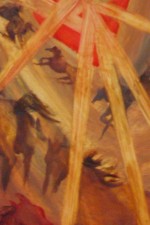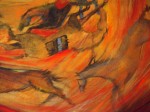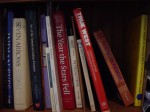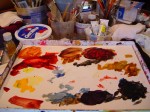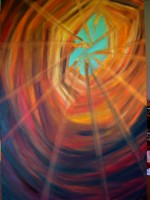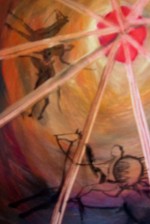 This image turned out a little blurry, but it is in keeping with my latest fear of imperfection philosophy: One must take action in order to move ahead. I feel I could have re-taken the photo and made it perfect. HOWEVER, the time and energy it would have taken to do it again, in this instance, would likely have prevented me from moving forward… it would have gone back into the “to do” pile, and likely not have gotten done. I often think people fail to move ahead, due to feeling incapacitated in knowing it may not be done 100% to perfection. Now, if this was a digital image of the finished piece, which I intended to save and use to promote the piece, that is another thing. But, to hope to get around to doing it more perfectly later, would likely have resulted in me not getting to it, or worse, not progressing with the painting!
This image turned out a little blurry, but it is in keeping with my latest fear of imperfection philosophy: One must take action in order to move ahead. I feel I could have re-taken the photo and made it perfect. HOWEVER, the time and energy it would have taken to do it again, in this instance, would likely have prevented me from moving forward… it would have gone back into the “to do” pile, and likely not have gotten done. I often think people fail to move ahead, due to feeling incapacitated in knowing it may not be done 100% to perfection. Now, if this was a digital image of the finished piece, which I intended to save and use to promote the piece, that is another thing. But, to hope to get around to doing it more perfectly later, would likely have resulted in me not getting to it, or worse, not progressing with the painting!
So, there you have it: a slightly blurred image, with the intent to show you how I draft in the subject matter of a painting. The tipi texture is created, and the illusion of depth has begun. The distortion of the figures is intentional, as this is a story told with the Native American as the victor. A story told around an evening fire: of a battle in which there is a pursuer and one being pursued.
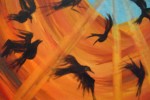 Doing several paintings to hang in the new Spearfish Crow Peak Brewery, I explored Native American legends regarding the Crow and the Sioux Indians. Enemies in earlier days, there are many winter count and ledger art records about battles between the two tribes. Paintings I did for the brewery explored the legend of how the local landmark, Crow Peak, got it’s name. There was a mighty battle in which the Crow Indians were defeated by the Sioux, and thus the name of the mountain.
Doing several paintings to hang in the new Spearfish Crow Peak Brewery, I explored Native American legends regarding the Crow and the Sioux Indians. Enemies in earlier days, there are many winter count and ledger art records about battles between the two tribes. Paintings I did for the brewery explored the legend of how the local landmark, Crow Peak, got it’s name. There was a mighty battle in which the Crow Indians were defeated by the Sioux, and thus the name of the mountain.
